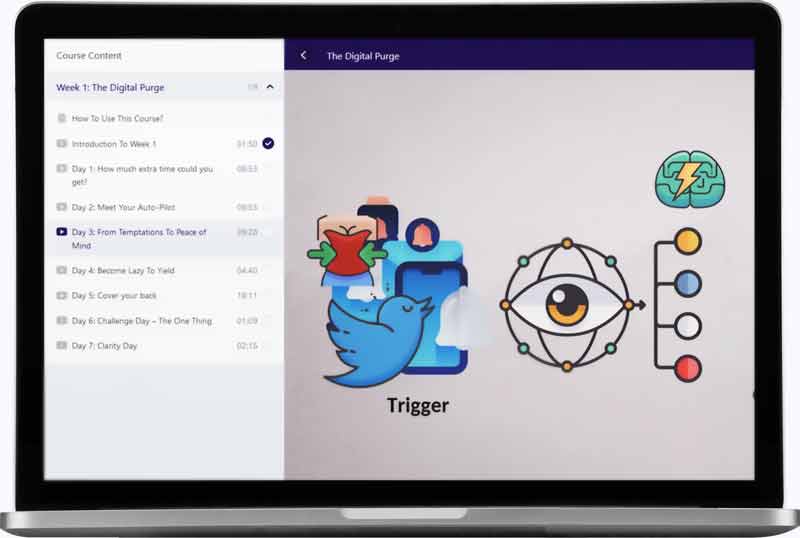Welcome to our digital detoxing series! A series on how to stop addictions to Fortnite,Facebook,Instagram,porn,Netflix, Youtube,Tinder… Find all the posts about digital addiction. Today, let’s talk about how to quit the zwift addiction.

- What’s the zwift addiction?
- Addiction to zwift, a “real” addiction?
- What’s considered zwift addiction
- How much zwift is too much?
- Some health and fitness addiction facts & statistics
- Symptoms & Causes of the zwift addiction
- Why is zwift so addictive?
- Possible causes of zwift dependency
- Symptoms, Causes and Signs of zwift addiction
- Problems, impacts & bad effects of zwift
- Some benefits of zwift
- health problems
- impact on brain & mental health
- impact on relationships
- How to stop & quit your zwift addiction
- Main steps and solutions to break the zwift addiction
- Best zwift blocker apps & functionalities
- where to seek extra help?
- Conclusion
- To Go Further
- How to help someone with zwift addiction
- Best books about health and fitness addiction
- Research about health and fitness addiction
What is the zwift addiction?
About zwift
Zwift is an online multiplayer training game that allows cyclists and runners to ride or run in virtual worlds, compete in races and workouts, and connect with other athletes from around the world using a smart trainer or treadmill and a computer, tablet, or smartphone.
Addiction to zwift, a “real” addiction?
Officially an addiction?
First, let’s have a look to the DSM-5,the Diagnostic and Statistical Manual of Mental Disorders. Does it includes zwift addiction?
No, Zwift addiction is not listed in the DSM-5 (Diagnostic and Statistical Manual of Mental Disorders). The DSM-5 is a manual used by mental health professionals to diagnose mental health disorders. While there is recognition of internet gaming disorder in the DSM-5, Zwift addiction specifically is not listed as a separate disorder. However, excessive use of Zwift or any other activity can still have negative effects on a person’s life and well-being. It is important to maintain a healthy balance of activities and seek professional help if necessary.
So what means “zwift addiction”?
Zwift addiction refers to the strong and compulsive desire to regularly participate in the virtual cycling and running platform, Zwift. Zwift is an online platform that simulates real-life cycling and running experiences through a computer or mobile device. It allows users to connect with other users from around the world, participate in organized races, and compete against others. Zwift addiction can be characterized by spending excessive amounts of time on the platform, prioritizing Zwift over other important activities, and experiencing negative consequences as a result of excessive use.
What is considered zwift addiction?
Here are some possible signs and symptoms of a potential Zwift addiction, which should be taken seriously and addressed promptly:
- 1. Spending excessive amounts of time on Zwift,to the point of neglecting other important aspects of life such as work, social relationships, and physical health.
- 2. Feeling irritable,anxious, or depressed when not able to access Zwift or complete a workout.
- 3. Obsessively tracking and analyzing Zwift data,such as power output, heart rate, and mileage, and feeling a sense of achievement or disappointment based on these metrics.
- 4. Prioritizing Zwift over other hobbies or interests,and declining invitations or opportunities to engage in other activities.
- 5. Spending significant amounts of money on Zwift equipment,such as a smart trainer, power meter, or virtual accessories.
- 6. Losing perspective on the virtual nature of Zwift,and experiencing a blurred sense of reality between the game and real life.
- 7. Neglecting personal hygiene or self-care in order to spend more time on Zwift.
It is important to remember that everyone has different levels of engagement with activities and hobbies. However, if you or someone you know is experiencing any of these symptoms to a significant degree, it may be a sign of an underlying issue that requires professional attention and support.
How much zwift is too much?
Spending too much time on Zwift can lead to burnout, overtraining, and neglect of other important aspects of life such as work, family, and social relationships. It is essential to find a balance between training on Zwift and other activities. It is recommended to consult a coach or a healthcare professional to determine an appropriate training schedule that suits your fitness level, goals, and lifestyle.
Some health and fitness addiction facts & statistics

There is limited research on the prevalence of health and fitness addiction. However, some studies suggest that it may affect up to 10% of the population.
Here are some statistics related to health and fitness addiction:
1. According to a study published in the Journal of Behavioral Addictions, 10% of gym-goers met the criteria for exercise addiction.
2. A study published in the International Journal of Mental Health and Addiction found that individuals with body dysmorphic disorder (BDD) were more likely to have exercise addiction. BDD affects approximately 2% of the population.
3. The National Eating Disorders Association (NEDA) states that excessive exercise is a common behavior among individuals with eating disorders, affecting up to 80% of individuals with anorexia nervosa.
4. A survey conducted by the International Health, Racquet & Sportsclub Association (IHRSA) found that 18% of gym-goers reported feeling guilty if they missed a workout, and 14% felt anxious or irritable if they couldn’t exercise.
It’s important to note that not all individuals who engage in frequent exercise or have a strong interest in health and fitness are addicted. Health and fitness addiction is characterized by compulsive and excessive exercise that interferes with daily life and causes physical and/or psychological harm.
Is the zwift addiction widespread?
It is difficult to estimate the exact number of people who are addicted to Zwift, as there is no official data available. However, Zwift has gained a significant following since its launch in 2014, and there are many athletes and fitness enthusiasts who use the platform regularly. Some users report that they enjoy the gamification aspect of Zwift and find it motivating to compete with others virtually. While there may be some individuals who struggle with addiction to Zwift or any other form of exercise, it is important to remember that moderate exercise is generally beneficial for both physical and mental health.
Symptoms, Causes and Signs of zwift addiction
Why is zwift so addictive?
There are several reasons why Zwift can be addictive:
- 1. Social Interaction:Zwift allows for social interaction with other riders from all around the world. This sense of community and the ability to connect with others can be very motivating and keep riders coming back.
- 2. Gamification:Zwift is designed to be a game-like experience, with levels to unlock, challenges to complete, and rewards to earn. This can provide a sense of achievement and progress that can be very motivating.
- 3. Real-time Feedback: Zwift provides real-time feedback on speed, power, and other metrics. This can be very addictive as riders strive to improve their performance and beat their previous bests.
- 4. Variety:Zwift offers a variety of routes and challenges, which can keep riders engaged and motivated. There is always something new to discover and explore.
- 5. Convenience:Zwift allows riders to train indoors, which can be more convenient and time-efficient than outdoor training. This convenience can make it easier for riders to stick to their training plans and see progress over time.
Possible causes of zwift dependency
- 1. Social connection:Zwift allows users to connect with other riders from all around the world, creating a sense of community and social interaction.
- 2. Achievement and competition:Zwift offers virtual races and challenges, providing a sense of accomplishment and motivation to continue riding.
- 3. Escapism:Zwift provides an escape from the stresses of daily life, allowing users to focus on the virtual world and forget about real-world problems.
- 4. Health and fitness goals:Zwift can be a useful tool for achieving fitness and weight loss goals, providing a sense of progress and accomplishment.
- 5. Technology and gamification:Zwift’s use of technology and gamification elements, such as unlocking new levels and virtual rewards, can be addictive for some users.
It’s important to note that while Zwift addiction may be a real phenomenon, it is not recognized as an official medical or psychological disorder. As with any activity, it’s important to practice moderation and balance in your use of Zwift and other digital platforms.
Signs & Symptoms of zwift addiction
Now let’s see if you have the zwift addiction problem.
- 1. You spend hours on Zwift:If you find yourself spending more time on Zwift than you do on other activities, this could be a sign that you are addicted. You might spend hours each day on your virtual bike, and find it difficult to tear yourself away.
- 2. You prioritize Zwift over other things:If you find yourself skipping other activities or social events in order to ride on Zwift, this could be a sign of addiction. You might find it difficult to say no to a workout, even if it means missing out on other things.
- 3. You plan your day around Zwift:If you plan your day around your Zwift workouts, this could be a sign of addiction. You might structure your work and other activities to fit in your rides, and find it difficult to deviate from your schedule.
- 4. You are constantly thinking about Zwift:If you find yourself thinking about Zwift all the time, even when you are not on your bike, this could be a sign of addiction. You might be constantly checking your stats and thinking about ways to improve your performance.
- 5. You get anxious if you can’t ride on Zwift: If you feel anxious or stressed when you cannot ride on Zwift, this could be a sign of addiction. You might feel like you are missing out on valuable training time, or worry that you will lose your fitness if you don’t ride.
- 6. You are obsessed with your Zwift avatar:If you spend a lot of time customizing your Zwift avatar and obsess over your outfit and equipment choices, this could be a sign of addiction. You might feel like your virtual self is an extension of your real self, and take your avatar’s performance very seriously.
- 7. You prioritize Zwift over outdoor riding:If you choose to ride on Zwift instead of riding outside, even when the weather is nice, this could be a sign of addiction. You might prefer the controlled environment of Zwift to the unpredictability of outdoor riding, or feel like you get a better workout on your virtual bike.
Problems, impacts & bad effects of zwift: should you quit?

What are some benefits of zwift
Zwift is a popular online cycling and running platform that has become increasingly popular over the years. Here are some of the pros and advantages of Zwift:
- 1. Realistic simulation:Zwift offers a realistic simulation of cycling and running that makes it feel like you are actually riding or running on the roads. The graphics and sound effects make it feel like you’re really outside.
- 2. Social aspect:Zwift allows you to connect with other cyclists and runners from around the world. You can join group rides, races, and events, and even chat with other users during your workout.
- 3. Convenience:With Zwift, you can train from the comfort of your own home, at any time of day. You don’t have to worry about traffic, weather, or finding a safe place to ride or run.
- 4. Training programs:Zwift offers a variety of structured training programs that can help you improve your fitness and achieve your goals. The programs are designed by professional coaches and tailored to your fitness level and goals.
- 5. Motivation:Zwift can be a great source of motivation for your workouts. The gamification of the platform, including achievements, challenges, and leaderboards, can help you stay motivated and engaged with your training.
Overall, Zwift is a great platform for cyclists and runners who want to train indoors with a realistic simulation of outdoor riding and running, social interaction, and structured training programs.But at the opposite, what can be some zwift addiction problems addicts suffer from?
general health problems
Zwift is an indoor cycling and training platform that has many potential health benefits. Here are some of the effects of Zwift on your health:
- 1. Improved cardiovascular health:Zwift workouts can help improve your heart health by increasing your cardiovascular endurance and reducing your risk of heart disease.
- 2. Increased stamina and endurance:Regular Zwift training can help improve your overall stamina and endurance, making it easier to complete longer and more challenging rides.
- 3. Weight loss:Zwift can be an effective tool for weight loss, as it provides a fun and engaging way to burn calories and increase your metabolism.
- 4. Reduced stress:Exercise, including Zwift, can help reduce stress and anxiety levels by releasing endorphins and improving mood.
- 5. Improved mental health:Regular exercise has been shown to improve mental health by reducing symptoms of depression and anxiety, improving cognitive function, and increasing self-esteem.
- 6. Better sleep:Exercise can help improve the quality of your sleep, making you feel more refreshed and energized throughout the day.
- 7. Increased muscle strength and tone:Zwift workouts can help improve your overall muscle strength and tone, especially in the legs, glutes, and core.
Overall, Zwift can be a great tool for improving your physical and mental health, but it’s important to remember that a balanced diet and regular exercise routine are also essential for optimal health.
zwift and sleep disorder
It is unlikely that Zwift can directly cause sleep disorders or problems. However, excessive use of technology, such as spending too much time on Zwift before bed, can disrupt sleep patterns and make it harder to fall asleep. The blue light emitted by screens can also interfere with the body’s natural production of melatonin, which can affect sleep. It is recommended to limit screen time before bed and establish a bedtime routine to promote healthy sleep habits.
zwift affecting your brain & mental health: bad for brain and mental health?
Some effects of zwift on your brain
There is limited research on the specific effects of Zwift on the brain. However, there are some potential negative effects of excessive screen time and sedentary behavior associated with Zwift that could impact the brain.
- 1. Reduced Attention Span:Spending long hours staring at a screen can lead to a reduction in attention span. This can affect the ability to concentrate and focus on tasks outside of the virtual world.
- 2. Decreased Creativity:Spending too much time in a virtual world can limit exposure to new experiences and ideas, which can negatively impact creativity.
- 3. Sleep Disturbances:Excessive screen time can disrupt the body’s natural sleep patterns, leading to sleep disturbances. Lack of adequate sleep can negatively affect brain function, including memory and cognitive abilities.
- 4. Addiction:Some individuals may become addicted to the virtual world of Zwift, leading to a lack of balance in their life and potential negative impacts on mental health.
Overall, while Zwift can be a fun and engaging way to exercise, it is important to find a balance between screen time and real-world experiences to ensure a healthy brain and lifestyle.
Some effects of zwift on your mental health
- 1. Addiction:Zwift can be addictive, just like any other video game or exercise program. Spending excessive amounts of time on Zwift can lead to neglect of other responsibilities, social isolation, and a decrease in overall well-being.
- 2. Comparison and competition:Zwift is a virtual platform where users can compete against each other, which can lead to feelings of inadequacy and low self-esteem if someone consistently loses or is not as good as others. This can also lead to a negative mindset and discourage people from continuing the program.
- 3. Burnout:Overdoing it on Zwift can lead to burnout, which can lead to a decrease in motivation and interest in cycling or exercising in general.
- 4. Unrealistic expectations:Zwift can create unrealistic expectations for fitness and performance, leading to disappointment and frustration if users don’t achieve their goals.
- 5. Lack of variety:Zwift can become monotonous if users don’t switch up their routines, leading to boredom and decreased motivation.
It’s important to remember that these negative effects are not guaranteed and can vary from person to person. Moderation, balance, and listening to your body and mind are important factors in maintaining mental and physical health while using Zwift or any other exercise program.
Does zwift cause stress and anxiety?
It is possible that Zwift, like any other form of exercise, can cause stress and anxiety in some individuals. However, it is important to note that exercise has been shown to reduce stress and anxiety in the majority of people. If you find that Zwift or any other form of exercise is causing you stress or anxiety, it may be helpful to talk to a healthcare professional or mental health provider to determine the best course of action for your individual needs.
Can zwift addiction lead to sadness and depression?

While it is possible for Zwift addiction to contribute to feelings of sadness and depression, it is unlikely to be the sole cause. Zwift addiction, like any other form of addiction, can lead to negative consequences such as neglecting other aspects of life, social isolation, and decreased physical health. These consequences can contribute to feelings of sadness and depression. However, it is important to note that depression is a complex mental health condition that can have multiple causes. If you are experiencing symptoms of depression, it is important to seek professional help from a mental health provider.
Dopamine and zwift
Dopamine is a neurotransmitter that is involved in the brain’s reward and pleasure centers. It is released when we experience something pleasurable or rewarding, such as when we exercise or achieve a goal.
Zwift is an online cycling and running platform that allows users to participate in virtual races and workouts. It has become a popular way for athletes to train and compete from the comfort of their own homes.
The combination of exercise and the virtual competition on Zwift can lead to the release of dopamine in the brain, which can make the experience even more rewarding and enjoyable. This can help to motivate athletes to continue training and participating in virtual races on the platform.
zwift effects on Focus, productivity, attention span, academic performance…
There is limited research on the specific effects of Zwift on focus, productivity, attention span, and academic performance. However, it is known that regular exercise has been shown to have positive effects on these cognitive functions.
Exercise has been found to increase blood flow to the brain, which can improve focus and attention span. It also releases endorphins, which can improve mood and reduce stress levels, leading to increased productivity.
Regular exercise has also been linked to improved academic performance, as it can enhance cognitive function, memory, and learning.
Therefore, it is possible that Zwift, as a form of exercise, could have similar positive effects on cognitive function and academic performance. However, more research is needed to fully understand the specific effects of Zwift on these areas.
A word about ADHD and zwift
It is possible that people with ADHD may interact differently with Zwift, but there is no clear consensus on this topic. Some people with ADHD may find that the interactive nature of Zwift is engaging and helps them stay focused and motivated during workouts. Others may struggle with the visual and auditory stimulation and find it difficult to stay focused on the task at hand.
Additionally, some people with ADHD may have difficulty with executive function skills, such as planning and organizing, which could impact their ability to set up and use Zwift effectively. It is important to note that everyone’s experience with ADHD is unique, and individual factors such as medication use, comorbid conditions, and personal preferences will also play a role in how they interact with Zwift.
affecting your relationships
zwift and self-esteem
Zwift, like any other form of exercise, can have a positive impact on self-esteem. Regular exercise has been shown to release endorphins, which can boost mood and reduce stress. This can lead to an increased sense of self-worth and confidence.
Zwift can also provide a sense of accomplishment and achievement as users set and achieve fitness goals. This can lead to a sense of pride and confidence in one’s physical abilities.
Additionally, Zwift offers a social aspect, with users able to connect and interact with other riders virtually. This can provide a sense of community and support, which can also boost self-esteem.
However, it’s important to note that self-esteem is a complex and multifaceted concept, and Zwift alone cannot guarantee a positive self-image. Other factors, such as genetics, personal history, and social support, also play a role in self-esteem.
zwift addiction leads to isolation and loneliness?
.jpg)
Yes, it is possible for Zwift addiction to lead to isolation and loneliness. When individuals become addicted to Zwift, they may spend excessive amounts of time on the platform, neglecting their social life and real-world interactions with friends and family. This can lead to feelings of loneliness and isolation as they become disconnected from the people around them. Moreover, if the addiction becomes severe, it may lead to neglect of responsibilities and daily activities, causing further isolation and loneliness. Therefore, it is essential to maintain a healthy balance between virtual and real-world interactions and seek help if Zwift addiction starts to impact one’s social life and mental health.
Effects of zwift on your relationship
Positive effects:
- 1. Common interest:If both partners are into cycling or fitness, Zwift can be a great way to share a common interest and spend time together.
- 2. Motivation:Zwift can be a great source of motivation for both partners to stay fit and healthy. They can challenge each other to complete goals or race against each other.
- 3. Convenience:Zwift allows couples to workout together without having to leave their home. This is especially helpful for those with busy schedules or those who live in areas with inclement weather.
- 4. Bonding:Working out together can increase emotional bonding and intimacy between partners.
Negative effects:
- 1. Time constraints:Zwift can be addictive and couples may end up spending too much time on it, which can cause neglect of other aspects of their relationship.
- 2. Competitive atmosphere:Zwift can create a competitive atmosphere that may cause tension and conflict between partners.
- 3. Physical differences:One partner may be more advanced or have a higher fitness level than the other, which can lead to feelings of inadequacy or resentment.
- 4. Isolation:Working out together on Zwift may lead to a lack of social interaction with others, which can lead to feelings of isolation and loneliness.
How To Stop & quit Your zwift Addiction
Finally you think you are addicted to zwift and you are wondering how to quit it? How to break and overcome your cravings for zwift?
Here are the best solutions, steps, supports, resources and help you can get to treat your zwift addiction.
Main steps and solutions to break the zwift addiction
Here are some general steps that could potentially help someone who is struggling with addiction:
- 1. Acknowledge the addiction:Recognize that you have a problem and that you need to take steps to address it.
- 2. Seek professional help:Consider speaking with a therapist, counselor, or addiction specialist who can help you understand the root causes of your addiction and provide guidance on how to overcome it.
- 3. Set boundaries:Limit your time spent on Zwift and establish boundaries for yourself. Consider setting a daily or weekly time limit, or taking breaks throughout the day to reduce your overall screen time.
- 4. Find alternative activities:Engage in activities that bring you joy and fulfillment, such as spending time with loved ones, pursuing hobbies, or exercising outdoors.
- 5. Build a support network:Surround yourself with supportive friends and family who can provide encouragement and accountability as you work to overcome your addiction.
- 6. Practice self-care: Take care of your physical and emotional health by getting enough sleep, eating a balanced diet, and engaging in stress-reducing activities such as meditation or yoga.
Remember that addiction is a complex issue and there is no one-size-fits-all solution. It is important to seek professional help and tailor your approach to your individual needs and circumstances.Actually, that’s what most documentation out there is about… However, quitting a digital addiction can be a bit trickier than that.
So our team, after testing many ways, designed a bulletproof way to overcome them. Here are some clear and practical steps that are very powerful to quit a digital addiction, including zwift:
1. Purge temptations: Get rid of zwift
First, cleaning your life from temptations is much easier than resisting to them. Disable or delete your zwift accounts, change the password and hide it somewhere you can’t access easily, keep your phone / computer far away… Out of sight out of mind.
Here is a video from our course the The Digital Purge. on how to add resistance to your temptations, so you become so lazy to engage with them that you give them up:


